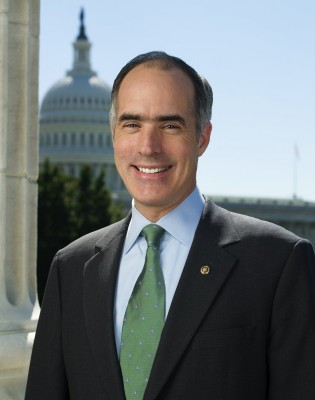Sen. Casey Calls on Agencies to Coordinate Investigation of Disease Clusters Linked to Environmental Contaminants
4 min read WASHINGTON, DC— In response to concerns about confirmed and unconfirmed disease clusters linked to environmental contaminants in Pennsylvania, U.S. Senator Bob Casey (D-PA) sent a letter to state and federal agencies urging greater coordination and sharing of information to help shed light on what causes abnormally high rates of diseases like cancer in some localized areas.
WASHINGTON, DC— In response to concerns about confirmed and unconfirmed disease clusters linked to environmental contaminants in Pennsylvania, U.S. Senator Bob Casey (D-PA) sent a letter to state and federal agencies urging greater coordination and sharing of information to help shed light on what causes abnormally high rates of diseases like cancer in some localized areas.
“I am very concerned about the four confirmed disease clusters linked to environmental contaminants in Pennsylvania,” wrote Senator Casey. “A more systematic, collaborative and integrated approach to investigating potential disease clusters is needed. There is a wealth of data being collected by each of your institutions; please enable it to be used to enhance our understanding and improve our ability to prevent and respond to environmental carcinogens.”
In his letter, Senator Casey called on the Environmental Protection Agency (EPA), the Centers for Disease Control and Prevention (CDC), the National Institute of Environmental Health Sciences and the Pennsylvania Department of Health to integrate various databases and registries currently in use to prevent the loss of information valuable to determining environmental factors that contribute to disease.
In addition to the four confirmed disease clusters in Pennsylvania, Senator Casey stated in his letter that he regularly hears from Pennsylvanians with concerns about other suspected sites, including a site possibly linked to the Butler Mine Tunnel Superfund site in Luzerne County and sites in Washington County where residents are concerned about a link between natural gas drilling and illness.
A copy of the letter is below.
The Honorable Lisa P. Jackson
Administrator
Environmental Protection Agency
Christopher Portier, PhD
Director
Agency for Toxic Substances and Disease Registry and the
National Center for Environmental Health
Centers for Disease Control and Prevention
Eli N. Avila, MD, JD, MPH, FCLM
Secretary of Health
Commonwealth of Pennsylvania
Pennsylvania Department of Health
Linda S. Birnbaum, Ph.D., D.A.B.T., A.T.S.
Director
National Institute of Environmental Health Sciences
Dear Administrator Jackson, and Drs. Portier, Avila, and Birnbaum,
As you know, nearly half of all Americans live with chronic disease, accounting for the majority of deaths, disabilities, and health care costs. Cancer is the second leading cause of death. The incidence of some cancers, including some most common among children, is rising.
I am very concerned about the four confirmed disease clusters linked to environmental contaminants in Pennsylvania. I regularly hear from Pennsylvanians about other suspected disease clusters such as a possible site linked to the Butler Mine Tunnel Superfund site in Luzerne County, Pennsylvania. I have also been informed of a potential site in Washington County, where residents are concerned that illnesses may be linked to natural gas drilling. Despite being above the normal rate, these disease groupings are often dismissed as statistically insignificant. Greater coordination is required among all relevant agencies to be more responsive in testing and identifying potential disease clusters in Pennsylvania and elsewhere.
Specific, actionable causes of chronic disease continue to elude us and are dauntingly difficult to determine. Even when a localized outbreak does not meet the strict definition of a disease cluster, the information on real-world exposures and health effects collected from those investigations is invaluable, yet easily lost. As you well know, the design, analysis, and interpretation of environmental health data is a costly and controversial endeavor. A more systematic, collaborative and integrated approach to investigating potential disease clusters is needed. One improvement I urge you to implement immediately is a fully comprehensive, relational database to enable the analysis of the information captured in these investigations.
I call on your Agencies to sign on to a Memorandum of Agreement establishing a relational database that integrates the various databases and registries currently in use by local, state, and federal entities. The statistically robust information needed to provide the best answers science can give us should be to gathered in a cohesive, comprehensive manner, or it will be lost. This database should be populated by those of you with data that may prove to be useful in the long term. It would enable sharing of data subsets between epidemiologists and other scientists who can study them to better quantify, and thereby focus management efforts on, specific health and environmental factors that most contribute to disease.
Many chemicals on the market today have not been tested for their carcinogenic potential. The difficulty of studying them may preclude us from limiting exposure to those that may be most harmful. No one has unequivocally quantified how much environmental exposure can be related to disease, yet it is widely accepted that most diseases are caused by a combination of genetic and environmental factors. There is a wealth of data being collected by each of your institutions; please enable it to be used to enhance our understanding and improve our ability to prevent and respond to environmental carcinogens.
I would appreciate hearing from each of you as to how you will advance the integration of the knowledge and expertise that your institutions bring to the issue. I believe these types of efforts will ultimately lead us to averting many cases of disease. In addition to the noble pursuit of preventing disease, we must do all we can to leverage cost-saving, information-building opportunities.
Thank you for your work protecting public health.
Sincerely,
Robert P. Casey, Jr.
United States Senator